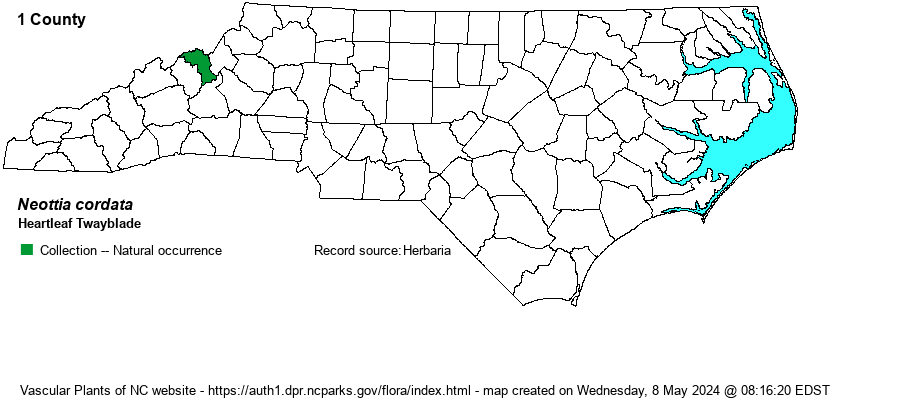| Author | (L.) L.C. Richard | |
| Distribution | One very old collection from the Mountains, reported as "Avery County" in RAB (1968). However, the specimen label at the Field Museum (Chicago) simply states "Collected in the mountains of North Carolina, by Messrs. Le Roy and Rugel. June, 1872". The specimen was later annotated with "Foot of Black". If this means "foot of the Black Mountains", then Yancey County or Mitchell County would be a more likely county; A. Weakley (pers. comm.) suggests that Mitchell is the more likely county, based on "modern county circumscriptions" plus his knowledge of dealing with previous similar vague specimen labels. For now, the website editors will move the specimen record on the map below from Avery County to Mitchell County, but knowing that the exact county seems to be uncertain. At least, the NCNHP staff, Weakley, and the website editors have now seen the specimen sheet (in April 2020) and agree on the identification.
This is a "Far Northern" species found across Canada but south mainly to NY, WI, and the Western states. There are scattered records for NJ, PA, and WV, but apparently none from VA. Thus, the old NC record was/is a considerable southern disjunct. | |
| Abundance | Historical -- not seen since 1872. As it has not been seen again in nearly 150 years, with many botanists scouring the Mountains, one might suggest a State Rank of SX (extirpated). However, appropriate habitat is not rare, and the NCNHP has the State Rank as SH, and listed it as Significantly Rare - Disjunct. | |
| Habitat | In its range, this is a species of spruce-fir and mixed conifer-hardwood forests, at least in the Appalachians. The NC habitat is not known, but it is surmised to have been in moist spruce-fir or spruce-hardwood forest. |
| Phenology | Blooms in June and July and fruits shortly after flowering. | |
| Identification | This is a tiny orchid that grows with a single purplish stem to only about 6-8 inches tall. It has a single set of paired (opposite) leaves on the stem; these are green, heart-shaped, and about 1 inch long. The inflorescence covers the top third to half of the stem, with up to 25 very small purplish flowers, each only about 1/4-inch across. The lip is forked (like with N. bifolia), but the lip is only about 1/8-inch long. The primary twayblade growing in the mountains is N. smallii, but that species has a larger lip that is only cleft and the lobes are quite rounded rather than forked. | |
| Taxonomic Comments | Owing to the fact that the species has a very wide range, there are several varieties. The one in the East is the nominate one -- L. cordata var. cordata. Some references use the genus of Neottia instead of Listera -- i.e., Neottia cordata for this species.
| |
| Other Common Name(s) | Lesser Twayblade | |
| State Rank | SH | |
| Global Rank | G5 | |
| State Status | SR-D | |
| US Status | | |
| USACE-agcp | FACW link |
| USACE-emp | FACW link |

